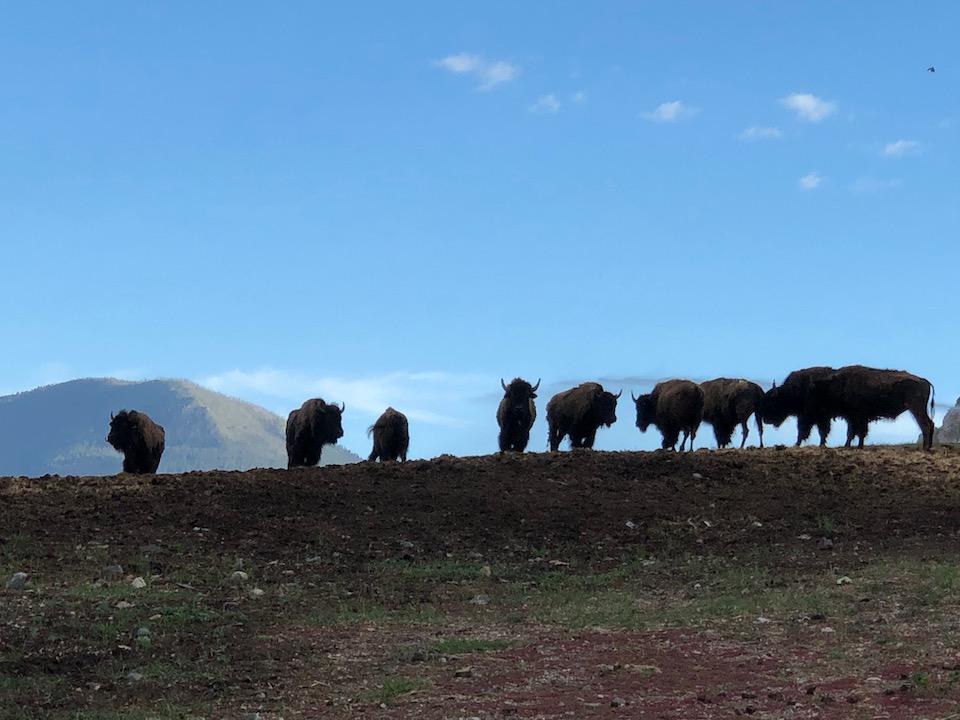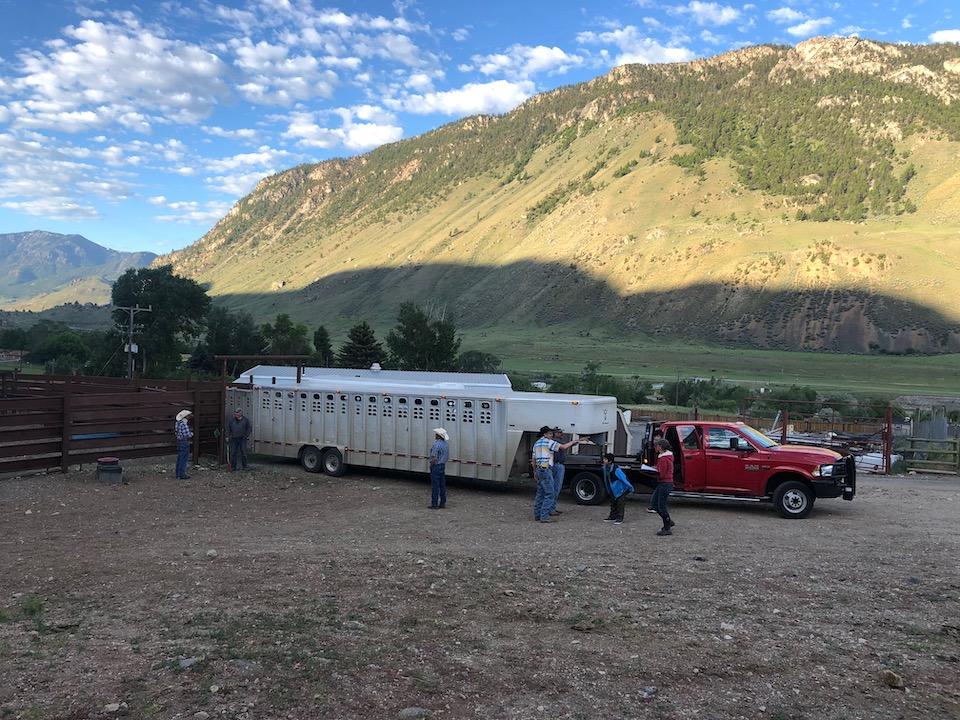
Yellowstone bison bulls grazing in the early hours of the morning before being transported to the Fort Peck Indian Reservation/Don Woerner
The bison pipeline from Yellowstone National Park to the Fort Peck Assiniboine and Sioux leaders in Montana continues to operate, with 11 more bison shipped from the park to the Fort Peck Indian Reservation.
With that shipment Wednesday, 104 bison will have been successfully transferred to the reservation. This is the fourth relocation since April 2019 under a new program that diverts brucellosis-free Yellowstone bison from slaughter to tribal-led restoration efforts.
Half or more of Yellowstone’s bison carry brucellosis, a cattle-introduced disease that, frankly, scares the hell out of ranchers.
Brucella abortus, a bacterium thought to have reached the country from European livestock, can cause spontaneous abortions or stillbirths in bison and cattle. Until 2010, if two or more herds in a state contracted the disease, or if a single herd detected to carry the disease was not sent to slaughter, all herds in that state were blacklisted from markets. Today that blacklisting applies only to the affected herd. Nevertheless, the risks of the disease infecting cattle have stigmatized Yellowstone bison and impacted their instincts to head outside the park for calving and prevented the spread of their genes to other bison herds in the West.
Yet the fact of the matter, according to the National Academy of Sciences, is that elk, not Yellowstone bison, are the culprit when it comes to spreading brucellosis.
The latest transfer to Fort Peck comes with additional symbolic importance. One of the trucks used to transport the bison was driven by Arnt Thomas “Rusty” Stafne, former Fort Peck tribal chairman and one of the early leaders of this Yellowstone bison restoration program. In 2012, Stafne made the original motion to move bison from Yellowstone to Fort Peck Reservation. His efforts led to successful pilot project releases of nearly 200 bison in 2012 and 2014, evolving into the conservation program it is today.
“Buffalo are critical to maintaining a link to our cultural legacy,” said Stafne. “After so many years of working on this effort, I’m proud to see this program succeed and bring buffalo home to stay.”
Defenders of Wildlife has been working with the Assiniboine and Sioux Tribes of the Fort Peck Indian Reservation on bison restoration since 1999, partnering with the tribes to secure state and federal political support and by contributing financially to the effort. In 2014, Defenders awarded its annual Wildlife Conservation Award to the tribes for their leadership in bison restoration. Then-Chairman Stafne accepted the award.

Fort Peck buffalo leaders loading 11 bison bulls at the USDA Corwin Springs facility outside Yellowstone National Park. The animals will be transported more than 500 miles today to the Fort Peck Indian Reservation, Montana/Don Woerner
“Over the past decade, our partnership with the buffalo leaders of Fort Peck has made it possible for bison to once again roam their historic lands across the Great Plains,” said Chamois Andersen, senior Rockies and Plains representative at Defenders of Wildlife. “This new program has already been a great success, saving over 100 bison from slaughter in a single year and with many more going to tribal herds in the years to come.”
Following their relocation to Fort Peck, the bison will remain in quarantine for one year before a final test for brucellosis. Once the 11 bison complete their final tests at Fort Peck, they will then be made available for translocation to other tribal herds, aiding with the continuing restoration of the species throughout its historic range. Previously, due to Yellowstone’s bison population limit, these bison—whether brucellosis positive or negative—were indiscriminately sent to slaughter.
Background
This is the fourth transfer of Yellowstone bison to Fort Peck under the new program. Five bison were transferred from the Yellowstone area in April 2019, another 55 were transferred in August 2019, and 33 bison came in January 2020.
Quarantine is the best option for translocating animals that test negative out of the Greater Yellowstone Ecosystem so that they can be used for restoration of the species.
The Fort Peck Assiniboine and Sioux Tribes are leaders in buffalo restoration and continue the expansion of their buffalo program, now at nearly 15,000 acres with a capacity for 375 buffalo.
Two transfers of bison to Fort Peck have occurred prior to this new program authorized by Yellowstone National Park. Under a pilot project approved by the state of Montana, 61 bison made the journey from the Yellowstone region to Fort Peck Reservation in 2012 where a crowd of tribal members and others waited to welcome bison home after a 120-year absence. Another 136 were relocated in 2014. Defenders of Wildlife assisted Fort Peck Tribes and the Montana governor’s office by arranging and paying for the transfer logistics.
The bison being sent to Fort Peck are direct descendants of the last bison saved from the slaughter of the 19th century. While the species once boasted a population of more than 30 million across North America, only about 1,000 remained by 1900, most in captivity. Though saved from extinction and numbering 500,000 today, almost all bison are managed as livestock and contain cattle genetics.




 Support Essential Coverage of Essential Places
Support Essential Coverage of Essential Places







Comments
Any number of Yellowstone Bison being saved is a conservation victory; however, this shipment of only eleven is still far too little. The article is basically correct; while Bison "once boasted a population of more than 30 million across North America, only about 1,000 remained by 1900, most in captivity." The only things I might add are that estimates of that original Bison population range from at least 30 million up to as many as 60 million and most of the "about 1,000" that "remained by 1900" were already hybridized even then. So, the genetics in each and every one of the remaining roughly less than 5,000 genetically pure Bison is effectively priceless from a conservation biology perspective.
Yes, it's great that this program is "saving over 100 bison from slaughter in a single year" and I sincerely commend everyone involved for their efforts. However, hundreds more of these genetically important animals are still being slaughtered every year. Yes, some individual animals do not and will not fit scientific or perhaps even just logistical transfer criteria; but, hunting and other culls, both tribal and otherwise, need to be restricted only to animals that are not viable transfer candidates. As the article implies, Fort Peck must be used, not simply to restore the genetic integrity of Fort Peck's herds, but as a vital clearinghouse for "translocation to other tribal herds, aiding with the continuing restoration of the species throughout its historic range." I would add that, under the right leadership, the American Prairie Reserve can be an important breeding site to help build and maintain a large enough reservoir of genetically pure specimens to serve as a hedge against stochastic events.
What are the tribal plans for these buffalo? Will some be used to stock freezers?
Some surely will stock freezers because every herd produces some individuals that ultimately have to be culled to maintain the health of the herd and fit the available range. I used to raise some rare and magnificent animals and it weighed on me when some had to go to slaughter; but, some simply were not viable fits for my herd and the amount of land I controlled limited my herd size. So, some went to other breeders; some went into the entertainment business; and some went into freezers. However, I would never have gone to that much trouble, work, and expense for freezer meat and the tribes would not go to this much extra effort just for freezer meat; there are other meat sources involving far less expense and far less effort.
The conservation biologists working with the tribes are convinced the tribes understand the importance of putting pure genetics into the herds and the working assumption is that, if culls take place, more heavily hybridized specimens already in tribal herds will be culled first. As the article indicates, Yellowstone Bison truly will "be made available for translocation to other tribal herds, aiding with the continuing restoration of the species throughout its historic range."
Great Work! Some transfers are much better than no transfers. Yellowstone Bison are pure-breed stock as well with decent genetics. Perhaps, American Prairie Reserve would be interested in these bison transfers as well.
cows are better
This is a worthwhile effort, but I don't remember that these animals are geneticly pure or even tested? Am I wrong? Let's not kid ourselves, all these herds will end up in freezers eventually. Yellowstone is only pushing their problem down the road to a more socially acceptable end, and this is one of the good options. It should br expanded as it is only a drop in the bucket.
I'm sorry, Enclave; but, yes, you are wrong. The Yellowstone herd is tested; to the best of modern science, they are genetically pure; no, they won't all end up in freezers eventually; and, no, Yellowstone is not just pushing their problem down the road to a more socially acceptable end.
And, by the way, despite the carefully crafted wording of your comment, it's true intent comes through loud and clear.
Easy Humphrey, its just a question and an opionion. The tribes will rightfully use these animals to build up a herd and use them for a food supply. Just like at Yellowstone there is a limit to how many animals an organization support.